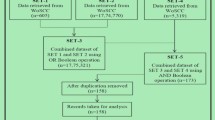Abstract
Academic discussion of pornography is generally restricted to issues arising from the depiction of adults. I argue that child-pornography is a more complex matter, and that generally accepted moral judgements concerning pornography in general have to be revised when children are involved. I look at the question of harm to the children involved, the consumers, and society in general, at the question of blame, and at the possibility of a morally acceptable form of child-pornography. My approach involves an objectivist meta-ethics and a utilitarian view of practical ethics, and I bring out the advantages of these theories to the consideration of moral issues such as this one.
Similar content being viewed by others
Notes
This passage suggests that Graham believes that, while the majority of people are consequentialists, most of those who disapprove of pornography are not. I’m not clear why he thinks this, though at the same time I accept that it’s more than possible that some anti-pornographers tailor their arguments to the beliefs of the people they want to persuade.
Indeed, I take it to be central to the issue of moral disagreement; that is, despite the objectivity of moral values, different cultures at different times have adopted what seem to be very different moral judgements. This paper is not the place to go into this issue in detail, but I hold that such disagreements can frequently be explained in terms of differences, not concerning moral values, but concerning metaphysics — especially what counts as a person, but also what counts as harm.
The same point could, of course, be made of rape-type adult-pornography.
It is also morally relevant that actual rape generally has little to do with sex, let alone love, being a matter of violence and domination, while (consensual) statutory rape can be much more complex.
It should be remembered that, in my hierarchy of types, I included in the rape-type category material produced by coercion even when only nudity or near-nudity are involved.
There is a parallel here with complaints about television programmes such as “The A-team”, in which every week tremendous amounts of violence occurred, but no-one was ever seriously hurt.
There is a parallel here with issues such as racism. The non-racist can find that her response to members of other races is affected by her awareness of the existence of racist attitudes — thus racism can infect society at large.
Except in the case of pseudo-child-pornography; see above, Section 5.
King 2008.
In fact there is good reason to suppose that Mill’s notion of intention included the foresight of consequences that are not directly willed (in Bentham’s terms, oblique intention). For a discussion of this see Ridge 2002; for a discussion of the relationship of the Utilitarian view to the Doctrine of Double Effect, see Oakley and Cocking 1994.
I exclude from all this those special cases in which the consumption of the pornography promotes it or is complicit in its production, as in the case of live performances. The utilitarian position is perfectly clear there.
Similarly, there is a difference between the emotional response to what we immediately experience (seeing someone being attacked, or seeing an example of rape-type child pornography) and the emotional response to a concept or idea (the idea of passive euthanasia, the concept of child pornography). There is more reason to be on our guard in the latter sort of case, because the processes of abstraction and categorisation are themselves open to question. We are more likely to find that our reason corrects our emotional response to an abstract or general idea than to a specific event.
References
Dyzenhaus D (1992) John Stuart Mill and the harm of pornography. Ethics 102:534–551
Easton SM (1994) The problem of pornography. Routledge, London
Elliott M (1992) Images of children in the media: soft kiddie porn. In: Itzin C (ed) Pornography: women, violence, and civil liberties. Oxford University Press, Oxford
Feinberg J (1987) The moral limits of the criminal law, vol 2: offence to others. Oxford University Press, Oxford
Graham G (1999) The internet: a philosophical inquiry. Routledge, London
Kelly L (1992) Pornography and child sex abuse. In: Itzin C (ed) Pornography: women, violence, and civil liberties. Oxford University Press, Oxford
King PJ (2008) In deepest consequence (forthcoming).
Longino HE (1995) Pornography, oppression, and freedom: a closer look. In: Dwyer S (ed) The problem of pornography. Wadsworth, Belmont, CA
Mackinnon CA (1995) Francis Biddle’s sister. In: Dwyer S (ed) The problem of pornography. Wadsworth, Belmont, CA
Mill JS (1861) Utilitarianism. In: Crisp R (ed). Oxford University Press, Oxford (1998)
Oakley J, Cocking D (1994) Consequentialism, moral responsibility, and the intention/foresight distinction. Utilitas 6:201–216
Parmar P (1988) Rage and desire. In: Chester G, Dickey J (eds) Feminism and censorship. Prism Press, Bridport, Dorset
Ridge M (2002) Mill’s intentions and motives. Utilitas 14:54–70
Scanlon T (1972) A theory of freedom of expression. Philos Public Aff 1:2:204–226
Snitow A (1985) Retrenchment versus transformation: the politics of the anti-pornography movement. In: Burstyn V (ed) Women against censorship. Douglas & McIntyre, Vancouver
Tate T (1992) The child pornography industry: international trade in child sexual abuse. In: Itzin C (ed) Pornography: women, violence, and civil liberties. Oxford University Press, Oxford
Wiggins D (1991) Needs, values, truth, 2nd edn. Basil Blackwell Ltd, Oxford
Acknowledgements
I should like to thank Andrea Christofidou and Peter Singer for their comments on earlier versions of this paper.
Author information
Authors and Affiliations
Corresponding author
Rights and permissions
About this article
Cite this article
King, P.J. No Plaything: Ethical Issues Concerning Child-pornography. Ethic Theory Moral Prac 11, 327–345 (2008). https://doi.org/10.1007/s10677-007-9095-1
Received:
Accepted:
Published:
Issue Date:
DOI: https://doi.org/10.1007/s10677-007-9095-1



